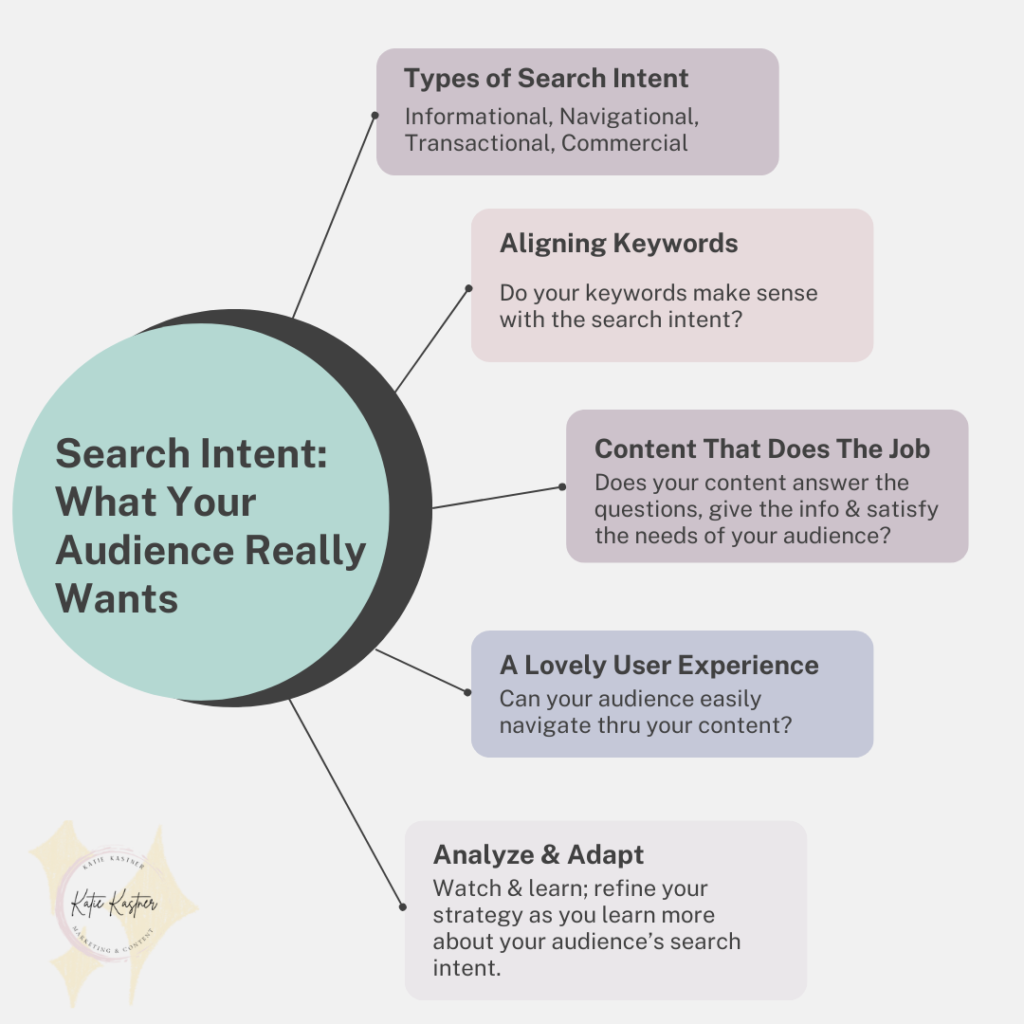We know that if you’re going to create content on the internet and you want that content to be found, you have to know SEO. And a big piece of SEO, especially these days with Google’s helpful content update, is understanding search intent and how to use it as part of your overall strategy.
Search intent is simply the reason behind a person’s search on the internet.
Think of the last time you Googled – you typed something into the search bar because you were hoping to find information, answers or solutions.
When you are planning your content and doing market and keyword research, you should also be thinking about the search intent of your target audience.
When you factor intent into content creation, you are increasing your website’s relevance, authority and ranking.

4 Types Of Search Intent
Let’s use Gracie, our fictional target audience, to learn more…
- Informational
Gracie is searching purely for more information. She wants to learn something, understand something or she might be starting the purchase process and doing some further research.
This search used to be a more broad one – “how to start a blog” – but what we are seeing is that users are becoming much more specific – “how to start a blog on a budget for a service business”. Same intent but more target keywords. - Navigational
Gracie is searching for a specific website, product, service, etc. Maybe she knows the brand name or the name of a person and she wants to go directly to that site.
This search will usually use words specific to a company or person. Those would be good target keywords. - Transactional
Gracie got online to make a purchase, book a service, sign up for a course, etc. – her search is purely transactional.
This search will, like navigational searches, use specific keywords. - Commercial Investigation
Gracie is almost ready to make a decision or purchase but she wants to do some comparison searching.
This search will usually be a “this vs. that” and content with keywords around product/service comparison will work.
Plan Your Keywords To Address Search Intent
When you are creating content, think about what the search intent for that piece of content would be. Then research the keywords that align with that search intent.
For example:
- Informational Intent
Use question-based keywords like “how to start a small business” or “what is SEO” – words that people might type when looking for info. - Navigational Intent
Create a service page like “Facebook Login” or “Amazon Customer Service” and incorporate your brand name or service-specific keyword. Put those keywords into your page’s meta data so users can quickly find what they are looking for. - Transactional Intent
Use product-specific and action-oriented keywords like “buy iPhone 12” or “subscribe to newsletter” to address people ready to make a purchase. - Commercial Investigation Intent
Focus on comparison and review keywords like “iPhone vs. Android” or “best web hosting services 2024” for people comparing options before buying.
Create Content With Search Intent In Mind
Once you know the intent you’re focusing on, the keywords to target, create content that effectively meets the searcher’s intention!
Use these guidelines to help you create content that:
- Understands The User Needs
Does your content address the specific questions or needs of your audience? If it doesn’t, rework it and try again. - Is Well Structured
Organize your content logically, using headings, subheadings and lists to make it easy for users (and search engines) to understand and navigate. - Includes Call-to-Actions (CTAs)
For transactional and commercial investigation intents especially, clearly direct users to the next steps they need to take, like purchasing or contacting for more information. - Use Relevant Keywords
Incorporate your aligned keywords naturally with the search intent. They should fit contextually and make sense within your content.
Search Intent & User Experience
A website that is easy to navigate, laid out logically and structured with search intent in mind will go far to help your rank higher in searches.
Good UX keeps your visitors engaged which reduces bounce rates and increases the likelihood of conversion.
A good user experience looks like:
- Fast Loading Times: Your website loads quickly to keep users engaged.
- Mobile Optimization: Your site is responsive on all devices for easy access and navigation.
- Clear Navigation: Your design includes intuitive menus and clear paths to important content.
Understanding and aligning your content with search intent is a key step in enhancing your website’s overall user experience and the all important SEO performance.
By creating content that addresses the specific needs and behaviors of your audience, you are setting the stage for more meaningful interactions and, eventually, conversions.
Remember, the goal is always to provide a seamless, intuitive user experience that not only meets but exceeds expectations!

Katie Kastner is a marketing strategist, content writer, chronically online elder millennial and champion of women entrepreneurs everywhere.
Her mission is the empower women business owners with the knowledge, tools and hell-yes mindset to build the empire of their dreams!
From marketing planning and content creation to mindset shifts for success, reach out and let’s see just how far you can go!
